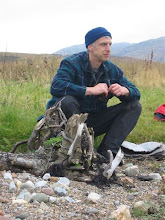
So what is all this about fluff. Well the Rannoch Brindled Beauty is a rare moth. Flanders Moss is the southerly edge of it is range that spreads north through the central highlands to Inverness. The degree of its rareness is described as Nationally Scarce A. Officially this means that it has only been recorded in between 16 and 30 10km squares since 1980. It was first recorded on Rannoch Moor in 1871 hence its name, its Latin name is Lycia lapponnaria scotica which apparently means wolf-like and refers to its shaggy body but this thick coat is more about keeping warm when the adults are out in the cool early spring. Flanders Moss is fairly typical habitat as it likes boggy moorland and heathland especially where its caterpillar food plants, bog myrtle and heather species, are found.
The adults hatch out in spring, the female has no wings (and looks like a bit of fluff) so just crawls up a fencepost or tree trunk and pumps out pheromones (chemicals) to attract in a winged male. Once they have mated the female climbs back down and searches for the dry flower heads of heather species and bog myrtle where she lays up to 150 greenish yellow eggs. The caterpillars hatch in May and eat their food plant until about August when they climb down and burrow underground to pupate. The pupal stage can last up to 4 years while the caterpillar breakdown into a moth soup before reforming as an adult moth. So the adult phase of the life cycle is only a blip compared with the prolonged larval stages.
But there is still much to be found out about this moths life at Flanders. We still haven't plotted its complete distribution on the moss. We also don't know exactly what its food plant preference is and if it has any other special requirements. For instance how important are trees to it ? All the moths recorded have been found on trees but is this only a fraction of the moths that are present ? As much of our management on Flanders is about removing trees from the Moss to keep the bog wet this is an important question to answer as we want to continue to host this special moth as we work to restore the wet bog of the past.


